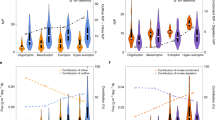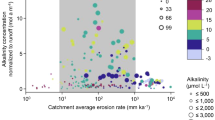Abstract
The recognition of lake acidification as an important environmental problem has recently stimulated the development of predictive models1–4 linking strong acid loading to lake pH or alkalinity. Among these models, the mass balance approach2 has been used to predict lake alkalinity from measured stream and precipitation chemistry and from watershed hydrology. This approach requires that all important positive or negative alkalinity fluxes within the system be considered. The diffusive loss of H+ to the sediments and loss of HCO3− from the sediments constitute potentially important sources of alkalinity in acid lakes. However, the relative importance of these fluxes has generally been overlooked and the presently available information appears to be limited to a few studies on the generation of alkalinity in anoxic hypolimnia3,4. The flux of alkalinity across the sediment–water interface is estimated here for one lake subject to relatively high acid deposition. For this lake, the estimated annual diffusive loss of alkalinity from the sediment to the overlying water was found to be as large as the combined measured acidity input from the watershed and from direct precipitation to the lake, thus showing the significant role of sediment–water interactions in the alkalinity balance of some acid lakes.
This is a preview of subscription content, access via your institution
Access options
Subscribe to this journal
Receive 51 print issues and online access
$199.00 per year
only $3.90 per issue
Buy this article
- Purchase on Springer Link
- Instant access to full article PDF
Prices may be subject to local taxes which are calculated during checkout
Similar content being viewed by others
References
Wright, R. F. Acid Rain Research: Predicting Acidification of North American Lakes (Rep. 4/1983, Norwegian Institute for Water Research, Oslo, 1983).
Dillon, P. J. in Environmental Impacts of Smelters (ed. Nriagu, J. O.) 283–347 (Wiley, New York, 1984).
Schindler, D. W., Wagemann, R., Cook, R. B., Ruszczynski, T. & Prokopowich, J. Can. J. Fish. aquat. Sci. 37, 342–354 (1980).
Kelly, C. A., Rudd, J. W. M., Cook, R. B. & Schindler, D. W. Limnol. Oceanogr. 27, 868–883 (1982).
Lazerte, B. D. & Dillon, P. J. Can. J. Fish. aquat. Sci. 41, 1664–1677 (1984).
Yan, N. D. & Miller, G. E. in Environmental Impacts of Smelters (ed. Nriagu, J. O.) 243–282 (Wiley. New York, 1984).
Hesslein, R. H. Limnol. Oceanogr. 21, 912–914 (1976).
Carignan, R. Limnol. Oceanogr. 29, 667–670 (1984).
Cline, J. D. Limnol. Oceanogr. 14, 454–458 (1969).
Carignan, R. & Nriagu, J. O. Geochim. cosmochim. Acta (in the press).
Berner, R. A. Early Diagenesis (Princeton University Press, 1980).
Stumm, W. & Morgan, J. J. Aquatic Chemistry 2nd edn (Wiley, New York, 1981).
Lasaga, A. C. Am. J. Sci. 279, 324–346 (1979).
Dillon, P. J. & Scheider, W. A. in Modeling of Total Acid Precipitation Impacts (ed. Schoor, L.) 121–154 (Butterworth, London, 1984).
Dillon, P. J., Jeffries, D. S. & Scheider, W. A. Wat. Air Soil Pollut. 18, 241–258 (1982).
Tessier, A., Rapin, F. & Carignan, R. Geochim. cosmochim. Acta 49, 183–194 (1985).
Li, Y.-H. & Gregory, S. Geochim. cosmochim. Acta. 38, 703–714 (1974).
Author information
Authors and Affiliations
Rights and permissions
About this article
Cite this article
Carignan, R. Quantitative importance of alkalinity flux from the sediments of acid lakes. Nature 317, 158–160 (1985). https://doi.org/10.1038/317158a0
Received:
Accepted:
Issue Date:
DOI: https://doi.org/10.1038/317158a0
This article is cited by
-
Hydrochemistry dynamics in remote mountain lakes and its relation to catchment and atmospheric features: the case study of Sabocos Tarn, Pyrenees
Environmental Science and Pollution Research (2015)
-
Thirty Years of Chemical Changes in Alpine Acid-Sensitive Lakes in the Alps
Water, Air, & Soil Pollution (2013)
-
Geochemistry of HCO3 − at the sediment-water interface of lakes from the Southwestern Chinese plateau
Water, Air, & Soil Pollution (1997)
-
Sediment diffusive fluxes of Fe, Mn, and P in a eutrophic lake: Contribution from lateral vs bottom sediments
Aquatic Sciences (1996)
-
Aluminum species in porewaters of Kejimkujik and Mountain Lakes, Nova Scotia
Water, Air, and Soil Pollution (1989)
Comments
By submitting a comment you agree to abide by our Terms and Community Guidelines. If you find something abusive or that does not comply with our terms or guidelines please flag it as inappropriate.



